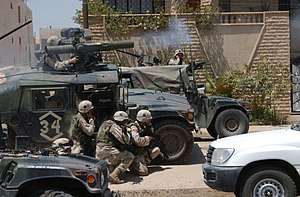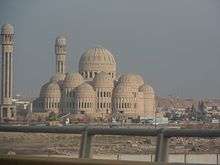Mosul
Mosul (Arabic: الموصل, romanized: al-Mawṣil, Kurdish: Mosil ,مووسڵ,[5][6] Syriac: ܡܘܨܠ, romanized: Māwṣil[7]) is a major city in northern Iraq. Located approximately 400 km (250 mi) north of Baghdad, Mosul stands on the west bank of the Tigris, opposite the ancient Assyrian city of Nineveh on the east bank. The metropolitan area has grown to encompass substantial areas on both the "Left Bank" (east side) and the "Right Bank" (west side), as the two banks are described by the locals compared to the flow direction of Tigris.
Mosul الموصل | |
|---|---|
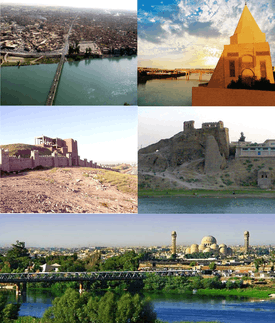 Tigris, a bridge and Grand Mosque in Mosul | |
| Nickname(s): Nīnwē ܢܝ݂ܢܘܹܐ | |
 Mosul Location of Mosul within Iraq 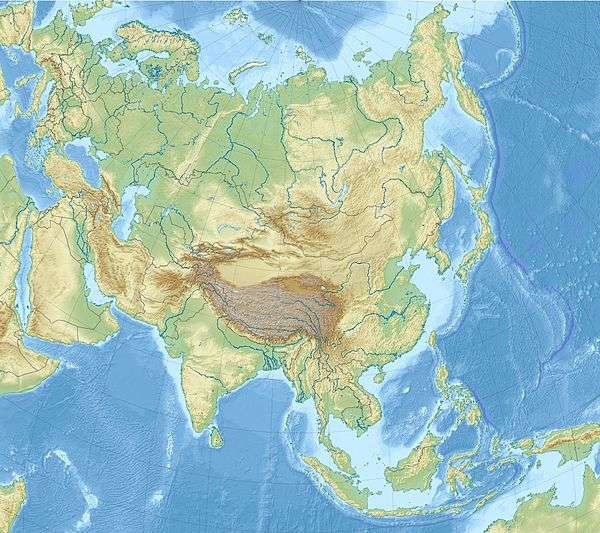 Mosul Mosul (Asia) | |
| Coordinates: 36.34°N 43.13°E | |
| Country | Iraq |
| Governorate | Nineveh Governorate |
| Area | |
| • City | 180 km2 (70 sq mi) |
| Elevation | 223 m (732 ft) |
| Population (2015) | |
| • City | 664,221 |
| • Urban | Unknown (estimates range between 750,000 and 1,500,000)[2] |
| UNData 1987[3] | |
| Demonym(s) | Moslawi, Mosuli[4] |
| Time zone | UTC+3 (AST) |
| Area code(s) | 60 |
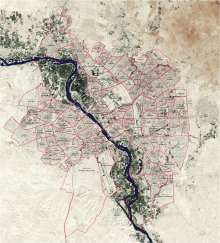
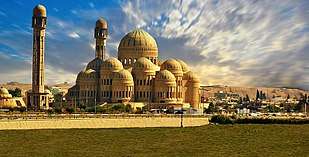
.jpg)
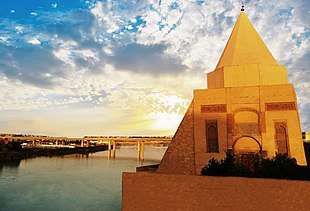

At the start of the 21st century, Mosul and its surroundings had an ethnically and religiously diverse population; the majority of Mosul's population were Arabs, with Assyrians,[8][9][10] Armenians, Turkmens, Kurds, Yazidis, Shabakis, Mandaeans, Kawliya, Circassians in addition to other, smaller ethnic minorities. In religious terms, mainstream Sunni Islam was the largest religion, but with a significant number of followers of the Salafi movement and Christianity (the latter followed by the Assyrians and Armenians), as well as Shia Islam, Sufism, Yazidism, Shabakism, Yarsanism and Mandaeism.
Mosul's population grew rapidly around the turn of the millennium and by 2004, the city's population was estimated to be 1,846,500.[11] In 2014, the Islamic State of Iraq and the Levant seized control of the city.[12] The Iraqi government recaptured it in the Battle of Mosul three years later, during which the city sustained heavy damage.
Historically, important products of the area include Mosul marble and oil. The city of Mosul is home to the University of Mosul and its renowned Medical College, which together was one of the largest educational and research centers in Iraq and the Middle East.
Mosul, together with the nearby Nineveh plains, is one of the historic centers for the Assyrian people[13][14] and their churches; the Chaldean Catholic Church, the Syriac Orthodox Church, and the Assyrian Church of the East, containing the tombs of several Old Testament prophets such as Jonah, some of which were destroyed by ISIL in July 2014.[15]
Etymology
The name of the city is first mentioned by Xenophon in his expeditionary logs in Achaemenid Assyria of 401 BC, during the reign of the Persian Achaemenid Empire. There, he notes a small Assyrian town of "Mépsila" (Ancient Greek: Μέψιλα) on the Tigris somewhere about where modern Mosul is today (Anabasis, III.iv.10). It may be safer to identify Xenophon's Mépsila with the site of Iski Mosul, or "Old Mosul", about 30 km (19 mi) north of modern Mosul, where six centuries after Xenophon's report, the Sasanian Empire's center of Budh-Ardhashir was built. Be that as it may, the name Mepsila is doubtless the root for the modern name.
In its current Arabic form and spelling, the term Mosul, or rather "Mawsil", stands for the "linking point" – or loosely, the "Junction City," in Arabic. Mosul should not be confused with the ancient Assyrian capital of Nineveh, which is located across the Tigris from the Old City of Mosul, on the eastern bank, at the famed archaeological mound of Kuyunjik (Turkoman for "sheep's hill"). This area is known today as the town of Nebi Yunus ("prophet Jonah") and is now populated largely by Kurds. It is the only fully Kurdish neighborhood in Mosul. The site contains the tomb of the Biblical Jonah, as he lived and died in the then capital of ancient Assyria. Today, this entire area has been absorbed into the Mosul metropolitan area. The indigenous Assyrians still refer to the entire city of Mosul as Nineveh (or rather, Ninweh).[16]
The ancient Nineveh was succeeded by Mepsila after the fall of Assyria between 612–599 BC at the hands of a coalition of Babylonians, Medes, Persians, Scythians, Cimmerians and Sagartians. The Assyrians largely abandoned the city, building new smaller settlements such as Mepsila nearby.[17]
Mosul is also named al-Faiha ("the Paradise"), al-Khaḍrah ("the Green"), and al-Hadbah ("the Humped"). It is sometimes described as "The Pearl of the North"[18] and "the city of a million soldiers".[19]
History
Ancient era and early Middle Ages
The area in which Mosul lies was an integral part of Assyria from as early as the 25th century BC. After the Akkadian Empire (2335–2154 BC), which united all of the peoples of Mesopotamia under one rule, Mosul again became a continuous part of Assyria proper from circa 2050 BC through to the fall of the Neo-Assyrian Empire between 612–599 BC. Mosul remained within the geopolitical province of Assyria for a further thirteen centuries (as a part of Achaemenid Assyria, Seleucid Syria, Roman Assyria and Sasanian Asōristān) until the early Muslim conquests of the mid-7th century. After the Muslim conquests, the region saw a gradual influx of Muslim Arab, Kurdish and Turkic peoples, although the indigenous Assyrians continue to use the name Athura for the ecclesiastical province.
Nineveh was one of the oldest and greatest cities in antiquity, and was settled as early as 6000 BC.[20] The city is mentioned in the Old Assyrian Empire (2025–1750), and during the reign of Shamshi-Adad I (1809–1776 BC) it is listed as a centre of worship of the goddess Ishtar, and it remained as such during the Middle Assyrian Empire (1365–1056 BC). During the Neo-Assyrian Empire (911–605 BC) Nineveh grew in size and importance, particularly from the reigns of Tukulti-Ninurta II and Ashurnasirpal II (883–859 BC) onward; he chose the city of Kalhu (the Biblical Calah, modern Nimrud) as his capital in place of the ancient traditional capital of Aššur (Ashur), 30 km (19 mi) from present day Mosul.
Thereafter successive Assyrian emperor-monarchs such as Shalmaneser III, Adad-nirari III, Tiglath-Pileser III, Shalmaneser V and Sargon II continued to expand the city. In approximately 700 BC, King Sennacherib made Nineveh the new capital of Assyria. Immense building work was undertaken, and Nineveh eclipsed Babylon, Kalhu and Aššur in both size and importance, making it the largest city in the world. A number of scholars believe the true location of the Hanging Gardens of Babylon were in fact at Nineveh.[21]
The mound of Kuyunjik in Mosul is the site of the palaces of King Sennacherib, and his successors Esarhaddon, Ashurbanipal, (who established the Library of Ashurbanipal), Ashur-etil-ilani, Sin-shumu-lishir and Sin-shar-ishkun. The Assyrian Empire began to unravel from 626 BC onwards, being consumed by a decade of brutal internal civil wars, greatly weakening it. A war-ravaged Assyria was subsequently attacked in 616 BC by a vast coalition of its former subjects, most notably their Babylonian relations from southern Mesopotamia, together with the Medes, Persians, Chaldeans, Scythians, Cimmerians, and Sagartians. Nineveh fell after a siege and bitter house to house fighting in 612 BC during the reign of Sin-shar-ishkun who was killed defending his capital. His successor, Ashur-uballit II, fought his way out of Nineveh and formed a new Assyrian capital at Harran (now southeastern Turkey).
Mosul (then the Assyrian town of Mepsila founded by the former inhabitants out of the ruins of their former capital) later succeeded Nineveh as the Tigris bridgehead of the road that linked Assyria and Anatolia with the short lived Median Empire and succeeding Achaemenid Empire (546–332 BC) where it was a part of the geopolitical province of Athura (Assyria), where the region, and Assyria in general, saw a significant economic revival.
Mosul became part of the Seleucid Empire after Alexander's conquests in 332 BC. While little is known of the city from the Hellenistic period, Mosul likely belonged to the Seleucid satrapy of Syria, the Greek term for Assyria, Syria originally meaning Assyria rather than the modern nation of Syria (see Etymology of Syria), which was conquered by the Parthian Empire circa 150 BC.
Mosul changed hands once again with the rise of the Sasanian Empire in 225 and became a part of the Sasanian province of Asōristān. Christianity was present among the indigenous Assyrian people in Mosul as early as the 1st century, although the ancient Mesopotamian religion remained strong until the 4th century. It became an episcopal seat of the Assyrian Church of the East in the 6th century.
In 637 (other sources say 641), during the period of the Caliph Umar, Mosul was annexed to the Rashidun Caliphate by Utba bin Farqad Al-Salami, during the early Arab Muslim invasions and conquests, after which Assyria was dissolved as a geopolitical entity.
9th century to 1535
.jpeg)
In the late 9th century control over Mosul was seized by the Turkish dynasts Ishaq ibn Kundaj and his son Muhammad, but in 893 Mosul came once again under the direct control of the Abbasid Caliphate. In the early 10th century Mosul came under the control of the native Arab Hamdanid dynasty. From Mosul, the Hamdanids under Abdallah ibn Hamdan and his son Nasir al-Dawla expanded their control over Upper Mesopotamia for several decades, first as governors of the Abbassids and later as de facto independent rulers. A century later they were supplanted by the Uqaylid dynasty. Ibn Hawqal, who visited Mosul in 968, described it as a beautiful town inhabited mainly by Kurds.[22]
Mosul was conquered by the Seljuq Empire in the 11th century. After a period under semi-independent atabeg such as Mawdud, in 1127 it became the centre of power of the Zengid dynasty. Saladin besieged the city unsuccessfully in 1182 but finally gained control of it in 1186. In the 13th century it was captured by the Mongols led by Hulagu Khan, but was spared the usual destruction since its governor, Badr al-Din Luʾluʾ, helped the Khan in his following campaigns in Syria.
After the Mongol defeat in the Battle of Ain Jalut against the Mamluks, Badr al-Din's son sided with the latter; this led to the destruction of the city, which later regained some importance but never recovered its original splendor. Mosul was thenceforth ruled by the Mongol Ilkhanate and Jalairid Sultanate and escaped Timur's destructions.
During 1165 Benjamin of Tudela passed through Mosul; in his papers he wrote that he found a small Jewish community estimated as 7,000 people in Mosul, the community was led by Rabbi Zakkai, presumably connected to the Davidic line. In 1288–1289, the Exilarch was in Mosul and signed a supporting paper for Maimonides.[23][24] In the early 16th century, Mosul was under the Turkmen federation of the Ağ Qoyunlu, but in 1508 it was conquered by the Safavid dynasty of Iran.
Ottoman period
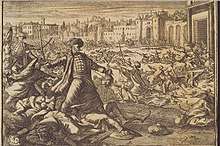
What started as irregular attacks in 1517 was finalized in 1538, when Ottoman Sultan Suleyman the Magnificent added Mosul to his empire by capturing it from his archrivals — Safavid Persia.[25] Thenceforth Mosul was governed by a pasha. Mosul was celebrated for its line of walls, comprising seven gates with large towers, a renowned hospital (maristan) and a covered market (qaysariyya), and was also famous for its fabrics and flourishing trades.
Although Mesopotamia had been acquired by the Ottoman Empire in 1555 by the Peace of Amasya, until the Treaty of Zuhab in 1639 Ottoman control over Mesopotamia was not decisive.[26] After the Peace of Amasya, the Safavids recaptured most of Mesopotamia one more time during the reign of king Abbas I (r. 1588–1629). Amongst the newly appointed Safavid governors of Mesopotamia during those years was Qasem Sultan Afshar, who was appointed governor of Mosul in 1622.[27][28] Prior to 1638, the city of Mosul was considered to the Ottomans "still a mere fortress, important for its strategic position as an offensive platform for Ottoman campaigns into Iraq, as well as a defensive stronghold and (staging post) guarding the approaches to Anatolia and to the Syrian coast. Then, with the Ottoman reconquest of Baghdad (1638), the liwa’ of Mosul became an independent wilaya."[29]:202
Despite being a part of the Ottoman Empire, during the four centuries of Ottoman rule Mosul was considered "the most independent district" within the Middle East, following the Roman model of indirect rule through local notables.[30]:203–204 "Mosuli culture developed less along Ottoman–Turkish lines than along Iraqi–Arab lines; and Turkish, the official language of the State, was certainly not the dominant language in the province."[29]:203
In line with its status as a politically stable trade route between the Mediterranean and the Persian Gulf Mosul developed considerably during the seventeenth and early eighteenth centuries. Similar to the development of the Mamluk dynasty in Baghdad, during this time "the Jalili family was establishing itself as the undisputed master of Mosul", and "helping to connect Mosul with a pre-Ottoman, pre-Turcoman, pre-Mongol, Arab cultural heritage that was to put the town on its way to recapturing some of the prestige and prominence it had enjoyed under the golden reign of Badr ad-Din Lu’lu’."[29]:203
Along with the al-Umari and Tasin al-Mufti families, the Jalilis formed an "urban-based small and medium gentry and a new landed elite", which proceeded to displace the control of previous rural tribes.[31] Such families proceed to establish themselves through private enterprise, solidifying their influence and assets through rents on land and taxes on urban and rural manufacturing.
As well as elected officials, the social architecture of Mosul was highly influenced by the Dominican fathers who arrived in Mosul in 1750, sent by Pope Benedict XIV (Mosul had a large Christian population, predominantly indigenous Assyrians).[32] They were followed by the Dominican nuns in 1873. They established a number of schools, health clinics, a printing press and an orphanage. The nuns also established workshops to teach girls sewing and embroidery.[33] A congregation of Dominican sisters, founded in the 19th century, still had its motherhouse in Mosul by the early 21st century. Over 120 Assyrian Iraqi Sisters belonged to this congregation.[32]
In the nineteenth century the Ottoman government started to reclaim central control over its outlying provinces. Their aim was to "restore Ottoman law, and rejuvenate the military" as well as reviving "a secure tax base for the government".[34]:24–26 In order to reestablish rule in 1834 the Sultan abolished public elections for the position of governor, and began "neutraliz[ing] local families such as the Jalilis and their class."[34]:28–29 and appointing new, non-Maslawi governors directly. In line with its reintegration within central government rule, Mosul was required to conform to new Ottoman reform legislation, including the standardization of tariff rates, the consolidation of internal taxes and the integration of the administrative apparatus with the central government.[34]:26
This process started in 1834 with the appointment of Bayraktar Mehmet Pasha, who was to rule Mosul for the next four years. After the reign of Bayraktar Mehmet Pasha, the Ottoman government (wishing still to restrain the influence of powerful local families) appointed a series of governors in rapid succession, ruling "for only a brief period before being sent somewhere else to govern, making it impossible for any of them to achieve a substantial local power base."[34]:29 Mosul's importance as a trading center declined after the opening of the Suez Canal, which enabled goods to travel to and from India by sea rather than by land across Iraq and through Mosul.

Mosul was the capital of Mosul Vilayet one of the three vilayets (provinces) of Ottoman Iraq, with a brief break in 1623 when Persia seized the city.
During World War I the Ottoman Empire sided with Germany, the Austro-Hungarian Empire and Bulgaria against the British Empire, France and the Russian Empire. In northern Mesopotamia, northern Syria and south east Turkey the Ottomans held the armed support of the Kurds, Turcomans, Circassians and some Arab groups, while the British and Russians were militarily supported by the Assyrians and Armenians (particularly in the wake of the Armenian genocide and Assyrian genocide), and some Arab groups. The Ottomans were defeated, and in 1918 the British occupied Mosul, and indeed the whole of Iraq.
1918 to 1990s
At the end of World War I in October 1918, after the signature of the Armistice of Mudros, British forces occupied Mosul. After the war, the city and the surrounding area became part of the British-occupied Iraq (1918–1920) and shortly Mandatory Iraq (1920–1932). This mandate was contested by Turkey, which continued to claim the area based on the fact that it was under Ottoman control during the signature of the Armistice.
In the Treaty of Lausanne, the dispute over Mosul was left for future resolution by the League of Nations. Iraq's possession of Mosul was confirmed by the League of Nations brokered agreement between Turkey and Great Britain in 1926. Former Ottoman Mosul Vilayet eventually became Nineveh Governorate of Iraq, but Mosul remained the provincial capital.
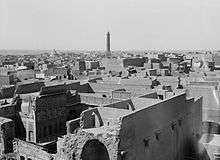
Mosul's fortunes revived with the discovery of oil in the area, from the late 1920s onward. It became a nexus for the movement of oil via truck and pipeline to both Turkey and Syria. Qyuarrah Refinery was built within about an hour's drive from the city and was used to process tar for road-building projects. It was damaged but not destroyed during the Iran–Iraq War.
The opening of the University of Mosul in 1967 enabled the education of many in the city and surrounding areas.
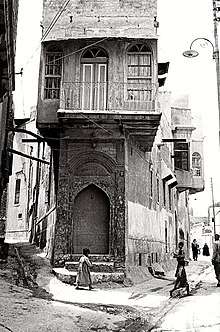

After the 1991 uprisings by the Kurds Mosul did not fall within the Kurdish-ruled area, but it was included in the northern no-fly zone imposed and patrolled by the United States and Britain between 1991 and 2003.
Although this prevented Saddam's forces from mounting large-scale military operations again in the region, it did not stop the regime from implementing a steady policy of "Arabisation" by which the demography of some areas of Nineveh Governorate were gradually changed. Despite the program Mosul and its surrounding towns and villages remained home to a mixture of Arabs, Kurds, Assyrians, Armenians, Turkmens, Shabaks, a few Jews, and isolated populations of Yazidis, Mandeans, Kawliya and Circassians.
Saddam was able to garrison portions of the 5th Army within the city of Mosul, had Mosul International Airport under military control, and recruited heavily from the city for his military's officer corps. This may have been due to the fact that most of the officers and generals of the Iraqi Army were from Mosul long before the Saddam regime era.
2003 American invasion
When the 2003 invasion of Iraq was being planned, the United States had originally intended to base troops in Turkey and mount a thrust into northern Iraq to capture Mosul. The Turkish parliament refused to grant permission for the operation, however. When the Iraq War did break out in March 2003, U.S. military activity in the area was confined to strategic bombing with airdropped special forces operating in the vicinity. Mosul fell on 11 April 2003, when the Iraqi Army 5th Corps, loyal to Saddam, abandoned the city and eventually surrendered, two days after the fall of Baghdad. U.S. Army Special Forces with Kurdish fighters quickly took civil control of the city. Thereafter began widespread looting before an agreement was reached to cede overall control to U.S. forces.
On 22 July 2003, Saddam Hussein's sons, Uday Hussein and Qusay Hussein, were killed in a gun battle with Coalition forces in Mosul after a failed attempt at their apprehension.[35] Mosul also served as the operational base for the US Army's 101st Airborne Division during the occupational phase of the Operation Iraqi Freedom. During its tenure, the 101st Airborne Division was able to extensively survey the city and, advised by the 431st Civil Affairs Battalion, non-governmental organizations, and the people of Mosul, began reconstruction work by employing the people of Mosul in the areas of security, electricity, local governance, drinking water, wastewater, trash disposal, roads, bridges, and environmental concerns.[36]
Other U.S. Army units to have occupied the city include the 4th Brigade Combat Team of the 1st Cavalry Division, the 172nd Stryker Brigade, the 3rd Brigade-2nd Infantry Division, 18th Engineer Brigade (Combat), Alpha Company 14th Engineer Battalion-555th Combat Engineer Brigade, 1st Brigade-25th Infantry Division, the 511th Military Police Company, the 812th Military Police Company and company-size units from Reserve components, an element of the 364th Civil Affairs Brigade, and the 404th Civil Affairs Battalion, which covered the areas north of the Green Line. The 67th Combat Support Hospital (CSH) Deployed in support of Operation Iraqi Freedom (OIF) from January 2004 to January 2005 running split based operations in Mosul and Tikrit. The Task Force (TF) 67 Headquarters and Company B operated out of Forward Operating Base (FOB) Diamondback (Mosul), and Company A operating out of FOB Speicher (Tikrit). [37]
On 24 June 2004, a coordinated series of car-bombs killed 62 people, many of them policemen.
On 21 December 2004, fourteen U.S. soldiers, four American employees of Halliburton, and four Iraqi soldiers were killed in a suicide attack on a dining hall at the Forward Operating Base (FOB) Marez next to the main U.S. military airfield at Mosul. The Pentagon reported that 72 other personnel were injured in the attack carried out by a suicide bomber wearing an explosive vest and the uniform of the Iraqi security services. The Islamist group Army of Ansar al-Sunna (partly evolved from Ansar al-Islam) declared responsibility for the attack in an Internet statement.
In December 2007, Iraq reopened Mosul International Airport. An Iraqi Airways flight carried 152 Hajj pilgrims to Baghdad, the first commercial flight since U.S. forces declared a no-fly zone in 1993, although further commercial flight remained prohibited.[38] On 23 January 2008, an explosion in an apartment building killed 36 people. The following day, a suicide bomber dressed as a police officer assassinated the local police chief, Brig. Gen. Salah Mohammed al-Jubouri, the director of police for Ninevah province, as he toured the site of the blast.[39]
In May 2008, a military offensive of the Ninawa campaign was launched by US-backed Iraqi Army Forces led by Maj. Gen. Riyadh Jalal Tawfiq, the commander of military operations in Mosul, in the hope of bringing back stability and security to the city.[40] Though the representatives of Mosul in the Iraqi Parliament, the intellectuals of the city, and other concerned humanitarian groups agreed on the pressing need for a solution to the unbearable conditions of the city, they still believed that the solution was merely political and administrative. They also questioned whether such a large-scale military offensive would spare the lives of innocent people.[41]
All these factors deprived the city of its historical, scientific and intellectual foundations in the last 4 years, when many scientists, professors, academics, doctors, health professionals, engineers, lawyers, journalists, religious clergy (both Muslims and Christians), historians, as well as professionals and artists in all walks of life, were either killed or forced to leave the city under the threat of being shot, exactly as happened elsewhere in Iraq in the years following 2003.[42][43][44][45]
Christian exodus
In 2008, many Assyrian Christians (about 12,000) fled the city, following a wave of murders and threats against their community. The murder of a dozen Assyrians, threats that others would be murdered unless they converted to Islam, and the destruction of their houses sparked a rapid exodus of the Christian population. Some families crossed the borders to Syria and Turkey while others were given shelter in churches and monasteries. Accusations were exchanged between Sunni fundamentalists and some Kurdish groups for being behind this new exodus. For the time being, the motivation of these acts is unclear, but some claims linked it to the imminent provincial elections that took place in January 2009, and the related Assyrian Christians' demands for broader representation in the provincial councils.[46][47]
Mosul was attacked on 4 June 2014. After six days of fighting, on 10 June 2014, the Islamic State took over the city during the June 2014 Northern Iraq offensive.[48][49][50] By August 2014, the city's new ISIL administration was initially dysfunctional. with frequent power cuts, tainted water supply, collapse of infrastructure support, and failing health care.[51]
Government by the Islamic State of Iraq and the Levant (ISIL)
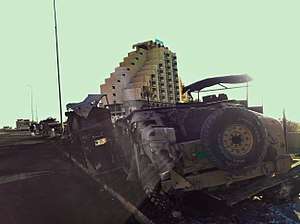
On June 10, 2014, the Islamic State of Iraq and the Levant took control of Mosul, after the Iraqi troops stationed there fled.[52][53] Troop shortages and infighting among top officers and Iraqi political leaders played into Islamic State's hands and fueled panic that led to the city's abandonment.[54] Kurdish intelligence had been warned by a reliable source in early 2014 that Mosul would be attacked by ISIL, and ex-Baathists had informed the U.S. and the UK;[55] nonetheless, Iraqi Prime Minister Nouri al-Maliki and the Defence Minister turned down repeated offers of help from the Peshmerga. Half a million people escaped on foot or by car during the next 2 days.[56]
ISIL acquired three divisions' worth of up-to-date American arms and munitions—including M1129 Stryker 120-mm mortars and at least 700 armoured Humvee vehicles from the then fleeing, or since massacred, Iraqi Army.[57] Many residents initially welcomed ISIL,[58] and according to a member of the UK's Defence Select Committee, Mosul "fell because the people living there were fed up with the sectarianism of the Shia dominated Iraqi government."[57]
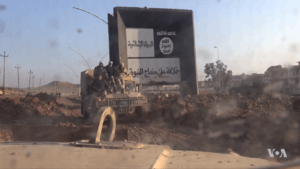
On 21 January 2015, the U.S. began coordinating airstrikes with a Kurdish-launched offensive, to help them begin the planned operation to retake the city of Mosul.[59]
Once home to at least 70,000 Assyrian Christians, there were possibly none left in Mosul following ISIL's takeover; any that did remain were forced to pay a tax for remaining Christian, and lived under the constant threat of violence.[60][61] The indigenous Assyrians of ancient Mesopotamian ancestry, who have a history in the region dating back over 5,000 years, suffered their Christian churches and monasteries being vandalized and burned down,[62] their ancient Assyrian heritage sites dating back to the Iron Age destroyed, and their homes and possessions seized by ISIL.[63] They also faced ultimatums to either convert to Islam, leave their ancient homelands, or be murdered.[63][64]
According to western and pro-Iraqi government press, the residents of the city were de facto prisoners,[65] forbidden to leave the city unless they left ISIL a significant collateral of family members, personal wealth and property. They may then leave the city after paying a significant "departure tax"[66] for a three-day pass (for a higher fee they can surrender their home, pay the fee and leave for good) and if those with a three-day pass fail to return within that time, their assets would be seized and their family would be killed.[67]
Most female Yazidis from Mosul and the greater Mosul region (Nineveh) were imprisoned and occasionally killed for resistance[68] to being sold as sex slaves.[69] Islamic State killed or expelled most minority groups and forcibly converted some Yazidi males and Christians to Islam. Women were required to cover their bodies from head to foot in a strict variant of Sharia rule, and men were required to fully grow their beards and hair in line with Islamic State edicts. Life in Mosul was one of violent oppression, where people suspected of activism against the occupiers, resistance activities, homosexuality, promiscuity or adultery were brutally and summarily tortured and murdered.[70]
The ISIL governor of Mosul, Alian Natiq Mabroush was killed on 18 March 2016, along with ten other jihadist leaders, in a U.S. airstrike.[71]
During the occupation, residents fought back against ISIL. In one notable incident, they were able to kill five ISIL militants and destroy two of their vehicles.[72]
While the Islamic State ruled Mosul with an extreme monopolization of violence and committed many acts of terror within Mosul, some scholars argue that the Islamic State also had a highly efficient bureaucratic government that ran a highly functioning state within Mosul's borders via sophisticated diwans (governing bodies).[73]
Women
Women were required to be accompanied by a male guardian[56][74] and wear clothing that covered their body completely, including gloves for the hands, niqab for the head, and khimar for the full coverage of the body from shoulders to feet.[70] Failure to follow the regulations was punished by fines or male relatives being given 40 or more lashes.[75]
According to Canadian-based NGO the RINJ Foundation, which operates medical clinics in Mosul,[76] rape cases in the city prove a pattern of genocide, and will lead to a conviction of genocide against the Islamic State, in the International Criminal Court, a permanent international tribunal to prosecute individuals for war-time rape, genocide, crimes against humanity, and aggression.[77][78]
In August 2015, ISIL was reported to be selling captured women and girls to sex slave traders.[79]
Persecution of religious and ethnic minorities and destruction of cultural sites
ISIL issued an edict expelling (in effect ethnically cleansing) the remaining predominantly ethnic Assyrian and Armenian Christian Mosul citizens, after the Christians refused to attend a meeting to discuss their future status. According to Duraid Hikmat, an expert on minority relationships and resident of Mosul, the Christians were fearful to attend.[80] Emboldened ISIL authorities systematically destroyed and vandalized Abrahamic cultural artifacts, such as the cross from St. Ephrem's Cathedral, the tomb of Jonah, and a statue of the Virgin Mary. ISIL militants destroyed and pillaged the Tomb of Seth in Mosul. Artifacts within the tomb were removed to an unknown location.[81]
Students from Muslim Shia and Sufi minorities were also been abducted.[12]
According to a UN report, ISIL forces persecuted ethnic groups in and near Mosul. The Assyrians, Kurds, Armenians, Yazidis, Turcoman, Mandeans, Kawliya and Shabaks were victims of unprovoked religiously motivated murders, assaults, theft, kidnappings, and the destruction of their cultural sites.[80]
- Mosque of the Prophet Yunus or Younis (Jonah): On one of the two most prominent mounds of Nineveh ruins, used to rise the Mosque (an Assyrian Church year) of Prophet Younis "Biblical Jonah". Jonah (Yonan) the son of Amittai, from the 8th century BC, is believed to be buried here, where King Esarhaddon of Assyria had once built a palace. It was one of the most important mosques in Mosul, and one of the few historic mosques that are found on the east side of the city. On 24 July 2014, the building was destroyed by explosives set by forces of Islamic State.[82]
- Mosque of the Prophet Jerjis (Georges): The mosque is believed to be the burial place of Prophet Jerjis. Built of marble with shen reliefs and renovated last in 1393 AD it was mentioned by the explorer Ibn Jubair in the 12th century AD, and is believed also to embrace the tomb of Al-Hur bin Yousif.
- Mashad Yahya Abul Kassem: Built in the 13th century it was on the right bank of the Tigris and was known for its conical dome, decorative brickwork and calligraphy engraved in Mosul blue marble.
- Mosul library: Including the Sunni Muslim library, the library of the 265-year-old Latin Church and Monastery of the Dominican Fathers and the Mosul Museum Library. Among the 112,709 books and manuscripts thought lost are a collection of Iraqi newspapers dating from the early 20th century, as well as maps, books and collections from the Ottoman period; some were registered on a UNESCO rarities list. The library was ransacked and destroyed by explosives on 25 February 2015.[83]
- Mosul Museum and Nergal Gate: Statues and artifacts that date from the Assyrian and Akkadian empires, including artefacts from sites including the Assyrian cities of Nineveh, Ashur, Arrapha, Dur-Sharrukin and Kalhu (Nimrud) and the Neo-Assyrian site of Hatra.[84][85] Their plans for uprising were accelerated when IS scheduled the destruction of the al-Ḥadbā[86]
- Turkish diplomats and consular staff were detained for over 100 days.[87]
Human rights
Scores of people were executed without fair trial.[88][89] Civilians living in Mosul were not permitted to leave ISIL-controlled areas. ISIL executed several civilians who tried to flee Mosul.[90]
Armed opposition
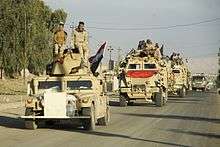
The urban guerrilla warfare groups may be called the Nabi Yunus Brigade after the Nabi Yunus mosque, or the Kataeb al-Mosul (Mosul Brigade).[91] The brigade claimed to have killed ISIL members with sniper fire.[92] In the countryside around Mosul, Kurdish and Assyrian militia also took up arms to resist ISIL oppression, and successfully repelled ISIL attacks on Kurdish and Assyrian towns and villages.[93][94]
Battle of Mosul (2016–2017)
After more than two years of ISIL occupation of Mosul, Iraqi, Kurdish, American and French forces launched a joint offensive to recapture the city on 16 October 2016.[95][96] The battle for Mosul was considered key in the military intervention against IS.[97] Turkish warplanes participated in the coalition strikes on Mosul, amid the escalating dispute between Baghdad and Ankara about the Turkish presence in Bashiqa.[98] A military offensive to retake the city was the largest deployment of Iraqi forces since the 2003 invasion by U.S. and coalition forces[99] On 9 July 2017, Prime Minister Haider Al-Abadi arrived in preparation to announce the full liberation of Mosul and reclamation of the city after three years of ISIL control.[100] A formal declaration was made on the next day.[101] The battle continued for another couple of weeks in the Old City, however, before Iraqi forces regained full control of Mosul on 21 July 2017.[102][103]
Demography
.jpg)
Mosul has had various ethnic groups during its history. In 1923, half of its population was Kurd.[104]During the 20th century, Mosul had been indicative of the mingling ethnic and religious cultures of Iraq. There used to be a Sunni Arab majority in urban areas, such as downtown Mosul west of the Tigris; across the Tigris and further north in the suburban areas, thousands of Assyrians, Kurds, Turkmens, Shabaks, Yazidis, Armenians and Mandeans made up the rest of Mosul's population.[105] Shabaks were concentrated on the eastern outskirts of the city.
Religion
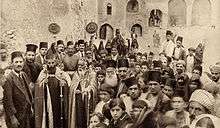
Mosul has a predominantly Sunni population. This city had an ancient Jewish population. Like their counterparts elsewhere in Iraq, most were forced out in 1950–51. Most Iraqi Jews have moved to Israel, and some to the United States.[106] In 2003, during the Iraq War, a rabbi in the American army found an abandoned, dilapidated synagogue in Mosul dating back to the 13th century.[107][108]
During the IS occupation, religious minorities were targeted by IS to convert to Islam, pay tribute (jizya) money, leave, or be killed.[109] The persecution of Christians in Mosul and the surrounding Nineveh Plains removed a Christian community that had been present in the region since the 1st century AD.[110]
Infrastructure
The Mosul Dam was built in the 1980s to supply Mosul with hydroelectricity and water. Water supply cuts are still common[111] and mobile phone networks have been shut down.[112] Several reports have described the dam as very dangerous and in need of repairs, repairs that could not be performed because of the war with ISIL. Unfortunately, over two million have fled the city of Mosul because of acts of terrorism.
There are five bridges crossing the Tigris in Mosul, known from north to south as:[113]
- Al Shohada Bridge (also known as "Third Bridge")
- Fifth Bridge
- Old Bridge (or "Iron Bridge", also known as "First Bridge")
- Al Huriya Bridge (literally: "Freedom Bridge", also known as "Second Bridge")
- Fourth Bridge
During the Battle of Mosul (2016–17) between ISIL and the Iraqi Army supported by an international coalition, two bridges were 'damaged' by coalition airstrikes in October 2016, two others in November, and the Old Bridge was 'disabled' in early December.[113] According to the BBC in late December, the bridges were targeted to disrupt the resupply of ISIL forces in East Mosul from West Mosul.[113] In January 2017, CNN reported that ISIL itself had 'destroyed' all bridges to slow the Iraqi ground troops' advance, citing Iraqi commander Lt. Gen. Abdul Amir Rasheed Yarallah.[114]
During the last stages of battle to retake Mosul, Lise Grande stated that per an initial assessment, basic infrastructure repair will cost over 1 billion USD. She stated that while stabilization in east Mosul can be achieved in two months, in some districts of Mosul it might take years with six out of 44 districts almost completely destroyed. All districts of Mosul received light or moderate damage.[115] Per the United Nations, 15 districts out of the 54 residential districts in the western half of Mosul were heavily damaged while at least 23 were moderately damaged.[116]
Mosul is served by Mosul International Airport.
Geography
Climate
Mosul has a hot semi-arid climate (BSh), verging on the Mediterranean climate (Csa), with extremely hot, prolonged, dry summers, brief and mild autumn and spring, and moderately wet, relatively cool winters.
| Climate data for Mosul | |||||||||||||
|---|---|---|---|---|---|---|---|---|---|---|---|---|---|
| Month | Jan | Feb | Mar | Apr | May | Jun | Jul | Aug | Sep | Oct | Nov | Dec | Year |
| Record high °C (°F) | 21.1 (70.0) |
26.9 (80.4) |
31.8 (89.2) |
35.5 (95.9) |
42.9 (109.2) |
44.1 (111.4) |
47.8 (118.0) |
49.3 (120.7) |
46.1 (115.0) |
42.2 (108.0) |
32.5 (90.5) |
25.0 (77.0) |
49.3 (120.7) |
| Average high °C (°F) | 12.4 (54.3) |
14.8 (58.6) |
19.3 (66.7) |
25.2 (77.4) |
32.7 (90.9) |
39.2 (102.6) |
42.9 (109.2) |
42.6 (108.7) |
38.2 (100.8) |
30.6 (87.1) |
21.1 (70.0) |
14.1 (57.4) |
27.8 (82.0) |
| Daily mean °C (°F) | 7.3 (45.1) |
9.1 (48.4) |
13.1 (55.6) |
18.2 (64.8) |
24.5 (76.1) |
30.3 (86.5) |
34.0 (93.2) |
33.4 (92.1) |
28.7 (83.7) |
22.1 (71.8) |
14.2 (57.6) |
9.0 (48.2) |
20.3 (68.6) |
| Average low °C (°F) | 2.2 (36.0) |
3.4 (38.1) |
6.8 (44.2) |
11.2 (52.2) |
16.2 (61.2) |
21.3 (70.3) |
25.0 (77.0) |
24.2 (75.6) |
19.1 (66.4) |
13.5 (56.3) |
7.2 (45.0) |
3.8 (38.8) |
12.8 (55.1) |
| Record low °C (°F) | −17.6 (0.3) |
−12.3 (9.9) |
−5.8 (21.6) |
−4.0 (24.8) |
2.5 (36.5) |
9.7 (49.5) |
11.6 (52.9) |
14.5 (58.1) |
8.9 (48.0) |
−2.6 (27.3) |
−6.1 (21.0) |
−15.4 (4.3) |
−17.6 (0.3) |
| Average precipitation mm (inches) | 62.1 (2.44) |
62.7 (2.47) |
63.2 (2.49) |
44.1 (1.74) |
15.2 (0.60) |
1.1 (0.04) |
0.2 (0.01) |
0.0 (0.0) |
0.3 (0.01) |
11.8 (0.46) |
45.0 (1.77) |
57.9 (2.28) |
363.6 (14.31) |
| Average precipitation days | 11 | 11 | 12 | 9 | 6 | 0 | 0 | 0 | 0 | 5 | 7 | 10 | 71 |
| Source 1: World Meteorological Organisation (UN)[117] | |||||||||||||
| Source 2: Weatherbase (extremes only)[118] | |||||||||||||
Historical and religious buildings
Mosul is rich in old historical places and ancient buildings: mosques, castles, churches, monasteries, and schools, many of which have architectural features and decorative work of significance. The town centre is dominated by a maze of streets and attractive 19th-century houses. There are old houses here of beauty. The markets are particularly interesting not simply for themselves alone but for the mixture of people who jostle there: Arabs, Kurds, Assyrians, Iraqi Jews, Kurdish Jews, Iraqi Turkmens, Armenians, Yazidi, Mandeans, Romani and Shabaks.
The Mosul Museum contains many interesting finds from the ancient sites of the old Assyrian capital cities Nineveh and Nimrud. The Mosul Museum is a beautiful old building, around a courtyard and with an impressive façade of Mosul marble containing displays of Mosul life depicted in tableau form. On February 26, 2015, IS militants destroyed the ancient Assyrian artifacts of the museum.
The English writer Agatha Christie lived in Mosul whilst her second husband, Max Mallowan, an archaeologist, was involved in the excavation in Nimrud.[119]
Mosques and shrines
- Umayyad Mosque: The first ever in the city, built in 640 AD by Utba bin Farqad Al-Salami after he conquered Mosul in the reign of Caliph Umar ibn Al-Khattab. The only original part extant to recent times was the remarkably elaborate brickwork 52m high minaret that leans like the Tower of Pisa, called Al-Hadba (The Humped). It was largely destroyed during the Battle of Mosul.
- The Great (Nuriddin) Mosque: Built by Nuriddin Zangi in 1172 AD next door to the Umayyad Mosque. Ibn Battuta (the great Moroccan traveller) found a marble fountain there and a mihrab (the niche that indicates the direction of Mecca) with a Kufic inscription. It was reportedly destroyed during the Battle of Mosul.
- Mujahidi Mosque: The mosque dates back to 12th century AD, and is distinguished for its shen dome and elaborately wrought mihrab.
- Prophet Younis Mosque and Shrine: Located east of the city, and included the tomb of Prophet Younis (Jonah), dating back to the 8th century BC, with a tooth of the whale that swallowed and later released him. It was completely demolished by IS in July 2014.[120]
- Prophet Jirjis Mosque and Shrine: The late 14th century mosque and shrine honoring Prophet Jirjis (George) was built over the Quraysh cemetery. It was destroyed by IS in July 2014.[121]
- Prophet Daniel Shrine: A Tomb attributed to Prophet Daniel was destroyed by IS in July 2014.[122][123]
- Hamou Qado (Hema Kado) Mosque: An Ottoman-era mosque in the central Maydan area built in 1881, and officially named Mosque of Abdulla Ibn Chalabi Ibn Abdul-Qadi.[124] It was destroyed by IS in March 2015 because it contained a tomb that was revered and visited by local Muslims on Thursdays and Fridays.[125]
Churches and monasteries
Mosul had the highest proportion of Assyrian Christians of all the Iraqi cities outside of the Kurdish region, and contains several interesting old churches, some of which originally date back to the early centuries of Christianity. Its ancient Assyrian churches are often hidden and their entrances in thick walls are not easy to find. Some of them have suffered from overmuch restoration.
- Shamoun Al-Safa (St. Peter, Mar Petros): This church dates from the 13th century is and named after Shamoun Al-Safa or St. Peter (Mar Petros in Assyrian Aramaic). Earlier it had the name of the two Apostles, Peter and Paul, and was inhabited by the nuns of the Sacred Hearts.
- Church of St. Thomas (Mar Touma in Assyrian Aramaic): One of the oldest historical churches, named after St. Thomas the Apostle who preached the Gospel in the East, including India. The exact time of its foundation is unknown, but it was before 770 AD, since Al-Mahdi, the Abbasid Caliph, is mentioned as listening to a grievance concerning this church on his trip to Mosul.
- Mar Petion Church: Mar Petion, educated by his cousin in a monastery, was martyred in 446 AD. It is the first Chaldean Catholic church in Mosul, after the union of many Assyrians with Rome in the 17th century. It dates back to the 10th century, and lies 3 m below street level. This church suffered destruction, and it has been reconstructed many times. A hall was built on one of its three parts in 1942. As a result, most of its artistic features have been severely damaged.
- Ancient Tahira Church (The Immaculate): Near Bash Tapia, considered one of the most ancient churches in Mosul. No evidence helps to determine its exact area. It could be either the remnants of the church of the Upper Monastery or the ruined Mar Zena Church. Al-Tahira Church dates back to the 7th century, and it lies 3 m below street level. Reconstructed last in 1743.
- Mar Hudeni Church: It was named after Mar Ahudemmeh (Hudeni) Maphrian of Tikrit who was martyred in 575 AD. Mar Hudeni is an old church of the Tikritans in Mosul. It dates back to the 10th century, lies 7 m below street level and was first reconstructed in 1970. People can get mineral water from the well in its yard. The chain, fixed in the wall, is thought to cure epileptics.
- St. George's Monastery (Mar Gurguis): One of the oldest churches in Mosul, named after St. George, located to the north of Mosul, was probably built late in the 17th century. Pilgrims from different parts of the North visit it yearly in the spring, when many people also go out to its whereabouts on holiday. It is about 6 m below street level. A modern church was built over the old one in 1931, abolishing much of its archeological significance. The only monuments left are a marble door-frame decorated with a carved Estrangelo (Syriac) inscription, and two niches, which date back to the 13th or 14th century.
- Mar Matte: This famous monastery is situated about 20 km (12 mi) east of Mosul on the top of a high mountain (Mount Maqloub). It was built by Mar Matte, a monk who fled with several other monks in 362 AD from the Monastery of Zuknin near the City of Amid (Diyarbakir) in the southern part of Asia Minor (modern Turkey) and the north of Iraq during the reign of Emperor Julian the Apostate (361–363 AD). It has a precious library containing Syrianic scriptures.
- Monastery of Mar Behnam: Also called Deir Al-Jubb (The Cistern Monastery) and built in the 12th or 13th century, it lies in the Nineveh Plain near Nimrud about 32 km (20 mi) southwest of Mosul. The monastery, a great fort-like building, rises next to the tomb of Mar Behnam, a prince who was killed by the Sassanians, perhaps during the 4th century AD. A legend made him a son of an Assyrian king.
- St. Elijah's Monastery (Dair Mar Elia): Dating from the 6th century, it was the oldest Christian Monastery in Iraq, until its destruction by IS in January 2016.[126][127]
Other Christian historical buildings:
- The Roman Catholic Church (built by the Dominican Fathers in Nineveh Street in 1893)
- Mar Michael
- Mar Elias
- Mar Oraha
- Rabban Hormizd Monastery, the monastery of Notre-Dame des Semences, near the Assyrian town of Alqosh
Other sites
- Bash Tapia Castle: A ruined castle rising high over the Tigris, which was one of the few remnants of Mosul's old walls until it was blown up by IS in 2015.
- Qara Serai (The Black Palace): The remnants of the 13th-century palace of Sultan Badruddin Lu'lu'.
Arts
Painting
The so-called Mosul School of Painting refers to a style of miniature painting that developed in northern Iraq in the late 12th to early 13th century under the patronage of the Zangid dynasty (1127–1222). In technique and style the Mosul school was similar to the painting of the Seljuq Turks, who controlled Iraq at that time, but the Mosul artists had a sharper sense of realism based on the subject matter and degree of detail in the painting rather than on representation in three dimensions, which did not occur. Most of the Mosul iconography was Seljuq—for example, the use of figures seated cross-legged in a frontal position. Certain symbolic elements, however, such as the crescent and serpents, were derived from the classical Mesopotamian repertory.
Most Mosul paintings were manuscript illustrations—mainly scientific works, animal books, and lyric poetry. A frontispiece painting, now held in the Bibliothèque nationale, Paris, dating from a late 12th century copy of Galen's medical treatise, the Kitab al-diriyak ("Book of Antidotes"), is a good example of the earlier work of the Mosul school. It depicts four figures surrounding a central, seated figure who holds a crescent-shaped halo. The painting is in a variety of whole hues; reds, blues, greens, and gold. The Küfic lettering is blue. The total effect is best described as majestic.
Another mid-13th century frontispiece held in the Nationalbibliothek, Vienna, to another copy of the same text suggests the quality of later Mosul painting. There is realism in its depiction of the preparation of a ruler's meal and of horsemen engaged in various activities, and the painting is as many hued as that of the early Mosul school, yet it is somehow less spirited. The composition is more elaborate but less successful. By this time the Baghdad school, which combined the styles of the Syrian and early Mosul schools, had begun to dominate. With the invasion of the Mongols in the mid-13th century the Mosul school came to an end, but its achievements were influential in both the Mamluk and the Mongol schools of miniature painting.
Education
As per IS policy, even primary schools were gender segregated, putting a strain on educational resources.[112] Previously the city's largest university, the University of Mosul was closed in 2014.[128] Many of the University's buildings were badly damaged and some were completely destroyed, but it has now reopened.[129]
On January 15, 2017, 30 schools reopened in the east of the city, allowing 16,000 children to start classes again. Some of them had no education at all since IS took over Mosul in June 2014.[130]
Sport
The city has one football team capable of competing in the top-flight of Iraqi football – Mosul FC.
Notable people
- Yousif Dhanoon (يوسف ذنون), Arabic calligrapher who designed and executed many inscriptions in mosques throughout the Islamic world.
- Zaha Hadid, World-famous architect and first woman to win the Pritzker award. Was named "dame" by Queen Elizabeth II.
- Al Jalili, Hussein Pasha, raised and led army to defend Mosul against Persian Shah Nadir Shah, 1743.
- Al Jalili, Ismael, Eye doctor who discovered and researched the Jalili syndrome.
- Al Jamil, Sayyar, Historian and political analyst.
- Abu Al Soof, Behnam, Archeologist, anthropologist, historian and writer of Christian ancestry.
- Tariq Aziz, Assyrian Deputy Prime Minister 1979–2003 (real name Michael Youkhanna) (from Tel Keppe)
- Munir Bashir, Assyrian musician and famous musician in the Mideast during the 20th century
- Asenath Barzani, first Jewish female rabbi
- Vian Dakhil, Yazidi member of the Iraqi parliament.
- Hawar Mulla Mohammed, Kurdish Iraqi soccer player for the national team
- Paulos Faraj Rahho, Assyrian Chaldean Catholic Archbishop of Mosul, assassinated 2008
- Taha Yassin Ramadan, Kurdish former Vice President of Iraq
- Hormuzd Rassam, Assyrian Archaeologist and diplomat of the 19th century
- Kathem Al Saher, Arab Iraqi pop singer, songwriter, and musician
- Salah al-Din al-Sabbagh, Arab Iraqi Army officer
- Salah Salim Ali, Norwegian Iraqi Writer and translator, author of Ibsen i Arabia.
- Ignatius Gabriel I Tappouni, Assyrian Patriarch of Antioch and all east for the Syriac Catholic Church between 1929 and 1968, Church Father of the Second Vatican Council and the first Eastern Rite prelate to be raised to the College of Cardinals since the reign of Pope Pius IX
- Behnam Afas, Iraqi-New Zealander author and researcher into the role of Christian scholars and missionaries
- Ghazi Mashal Ajil al-Yawer, Arab Interim President of Iraq during 2004–05
- Ignatius Zakka I, Assyrian Patriarch of Antioch and all east for the Syriac Orthodox Church
- Mosul Eye, Mosul Eye (Arabic: عين الموصل) is a news blog created and maintained by historian and citizen journalist Omar Mohammed.
See also
- Al-Mishraq, site of 2003 sulfur dioxide disaster
- Assyrian homeland
- Asteroid 22292 Mosul named after the city in 2018
- Battle of Mosul (2016–17)
- Chaldean Catholic Archeparchy of Mosul
- List of Emirs of Mosul
- List of places in Iraq
- Mosul Question
- Nineveh plains
- Tel Keppe
- Yazidi genocide
References
- Gladstone, Philip (10 February 2014). "Synop Information for ORBM (40608) in Mosul, Iraq". Weather Quality Reporter. Retrieved 16 June 2014.
- "Iraqi City of Mosul Transformed a Year After Islamic State Capture". Wall Street Journal.
- "UNSD Demographic Statistics". United Nations Statistics Division 1987.
- الموصل, Mosul Eye عين (October 5, 2019). "Mosulis are now heading to hospitals to donate blood to Baghdadis. Iraqis are united and this protest is a great indication of how united we are".
- "Nêçîrvan Barzanî: Serxwebûn Mafê Gelê Kurd E" (in Kurdish). Voice of America. Retrieved 13 March 2020.
- "ئەمساڵ كۆنسۆڵخانەى توركيا لە مووسڵ دووبارە دەكرێتەوە" (in Kurdish). Anadolu Agency. Retrieved 13 March 2020.
- Thomas A. Carlson et al., “Mosul — ܡܘܨܠ ” in The Syriac Gazetteer last modified June 30, 2014, http://syriaca.org/place/139.
- Soane, E.B. To Mesopotamia and Kurdistan in Disguise. John Murray: London, 1912. p. 92.
- Rev. W.A. Wigram (1929). The Assyrians and Their Neighbours. London.
- Unrepresented Nations and People Organization (UNPO). Assyrians the Indigenous People of Iraq [1]
- "Mosul". Encyclopedia of the Modern Middle East and North Africa. 1 January 2004.
- "Report on the Protection of Civilians in Armed Conflict in Iraq: 6 July – 10 September 2014" (PDF). UNAMI and OHCHR. Retrieved 21 December 2014.
- Dalley, Stephanie (1993). "Nineveh After 612 BC." Alt-Orientanlische Forshchungen 20. p.134.
- Robert D Biggs – "Especially in view of the very early establishment of Christianity in Assyria and its continuity to the present and the continuity of the population, I think there is every likelihood that ancient Assyrians are among the ancestors of modern Assyrians of the area."
- Dana Ford & Mohammed Tawfeeq (25 July 2014). "ISIS militants destroy the tomb of Jonah". CNN.
- Dalley, Stephanie (1993) "Nineveh After 612 BC," Alt-Orientanlische Forshchungen 20, p.134
- Reuters article – reprinted in Nabu Magazine, Vol. 3, Issue 1 (1997)
- "Mosul, Iraq" from AtlasTours.net
- "The war against Islamic State (2): Mosul beckons". The Economist. 11 April 2015. Retrieved 22 April 2015.
- "Nineveh". Max Mallowan.
- Dalley, Stephanie, (2013) The Mystery of the Hanging Garden of Babylon: an elusive World Wonder traced, Oxford University Press. ISBN 978-0-19-966226-5
- Bosworth, Edmund (2007). Historic Cities of the Islamic World. Brill. p. 414. ISBN 9789047423836.
- עזרא לניאדו, יהודי מוצל, מגלות שומרון עד מבצע עזרא ונחמיה, המכון לחקר יהדות מוצל, טירת-כרמל: ה'תשמ"א.
- Davidson, Herbert A. (2005). Moses Maimonides: The Man and His Works. New York: Oxford University Press. p. 560. ISBN 0-19-517321-X.
- Rothman 2015, p. 236.
- Shaw, Stanford J.; Shaw, Ezel Kural (1976). History of the Ottoman Empire and Modern Turkey: Volume 1, Empire of the Gazis: The Rise and Decline of the Ottoman Empire 1280–1808. Cambridge: Cambridge University Press. p. 199. ISBN 978-0-521-29163-7.
- Nasiri & Floor 2008, p. 248.
- Oberling 1984, pp. 582–586.
- Kemp, Percy (1983). "Power and Knowledge in Jalili Mosul". Middle Eastern Studies. 19 (2): 201–12. doi:10.1080/00263208308700543.
- Al-Tikriti, Nabil (2007). "Ottoman Iraq". Journal of the Historical Society. 7 (2): 201–11. doi:10.1111/j.1540-5923.2007.00214.x.
- Khoury, Dina Rizk (1997), State and Provincial Society in the Ottoman Empire. Mosul, 1540–1834, Studies in Islamic Civilization, Cambridge, p. 19
- Woods, Richard (2006). "Iraq Perspectives: Catholics and Dominicans in Iraq". Dominican Life. Retrieved 2009-09-13.
- Rasam, Suha (2005). Christianity in Iraq: Its Origins and Development to the Present Day. Gracewing. ISBN 9780852446331. Retrieved 2009-09-13.
- Shields, Sarah D. (2000). Mosul Before Iraq; Like Bees Making Five-Sided Cells. Albanay: State University of New York Press. ISBN 0-7914-4487-2.
- Pentagon: Saddam's sons killed in raid . CNN.com (2003-07-22). Retrieved on 2011-07-02.
- Mosul. Globalsecurity.org. Retrieved on 2011-07-02.
- https://www.stripes.com/news/w%C3%BCrzburg-hospital-team-is-home-from-iraq-1.28212
- "Iraq reopens Mosul airport after 14 years – US military".
- Gamel, Kim (January 25, 2008). "Provincial Police Chief Killed in Mosul". Associated Press.
- "Sadrists and Iraqi Government Reach Truce Deal". New York Times. May 11, 2008.
- "Archived copy" (PDF). Archived from the original on October 11, 2013. Retrieved 2009-03-12.CS1 maint: archived copy as title (link) CS1 maint: BOT: original-url status unknown (link)
- "Plight of Iraqi Academics" (PDF). Archived from the original on May 15, 2006. Retrieved 2008-05-10.CS1 maint: BOT: original-url status unknown (link)
- "Human Rights in Iraq". Archived from the original on June 29, 2006. Retrieved 2009-03-12.CS1 maint: BOT: original-url status unknown (link)
- "Iraq's deadly brain drain". France 24. Archived from the original on 2011-05-21. Retrieved 2011-07-02.
- "Losing Mosul?". Time. October 16, 2004. Retrieved May 13, 2010.
- Muir, Jim. (2008-10-28) "Iraqi Christians' fear of exile". BBC News. Retrieved on 2011-07-02.
- "Christians flee Iraqi city after killings, threats, officials say Archived 2008-10-12 at the Wayback Machine." CNN. 11 October 2008.
- Abdulrahim, Raja (5 October 2014). "Iraqi Kurdish forces moving toward complex battle in Mosul". The Los Angeles Times. Retrieved 21 December 2014.
- "Iraq's battles need sense of resolve". BBC News.
- Iraq, Islamic State, Baghdad, War, Al monitor, Sep 2014, archived from the original on 2014-10-19, retrieved 2014-10-19
- Laila Ahmed. "Since Islamic State swept into Mosul, we live encircled by its dark fear". The Guardian.
- "Iraqi insurgents seize city". BBC. 11 June 2014.
- "Militant group seizes cities in Iraq". CNN. 11 June 2014.
- "How Mosul fell – An Iraqi general disputes Baghdad's story". Reuters. 14 October 2014.
- Spencer, Richard (22 June 2014). "How US and Britain were warned of Isis advance in Iraq but 'turned a deaf ear'". The Daily Telegraph. Retrieved 21 December 2014.
- "Since Islamic State swept into Mosul, we live encircled by its dark fear". The Guardian. 29 August 2014.
- Holloway, Adam (26 September 2014). "Sharing a border with Isil – the world's most dangerous state". The Daily Telegraph. Retrieved 21 December 2014.
- "Under an ISIS Flag, the Sons of Mosul Are Rallying". The Daily Beast. 16 June 2014.
- Morris, Loveday (January 22, 2015), "Kurds say they have ejected Islamic State militants from large area in Northern Iraq", The Washington Post, retrieved January 25, 2015
- "You are being redirected..." Archived from the original on 2016-02-03.
- Judit Neurink (June 19, 2014). "Mosul Christians Out of the City for Good". Rudaw.
- "ISIS destroy the oldest Christian monastery in Mosul, Iraq". Archived from the original on 2016-02-02.
- Hawramy, Fazel (24 July 2014). "'They are savages,' say Christians forced to flee Mosul by Isis" – via The Guardian.
- "Patrick Cockburn reports on the brutal reality of life in Mosul under Isis". 9 November 2014.
- Loveday morris (October 19, 2015). "Isis in Iraq: Mosul residents are paying traffickers and risking their lives to escape cruel grip of Islamic State". The Independent.
- Sinan Salaheddin (March 13, 2015). "ISIS Blocks Trapped Residents From Leaving Iraq's Mosul". Huffington Post. Archived from the original on August 25, 2015.
- Abdelhak Mamoun (Mar 11, 2015). "ISIS warns people of Mosul not to leave city". Iraqi News.
- Micheal O'Brien (October 2, 2015). "Catching The ISIS Child Sex Slave Traders in Mosul Iraq". The RINJ Foundation.
- Priya Joshi. "Isis: Hundreds of Yazidi captives slaughtered in Mosul". International Business Times.
- Laila Ahmed (9 June 2015). "Inside Mosul: What's life like under Islamic State?". BBC News.
- "ISIS governor of Mosul killed in coalition airstrike – ARA News". 18 March 2016.
- "Mosul residents clash with ISIS members - Iraqi News".
- al-Tamimi, Aymenn (August 2015). "The Evolution in Islamic State Administration: The Documentary Evidence". Perspectives on Terrorism. 9.
- "Islamic State crisis: Mother fears for son at Mosul school". BBC News. 29 September 2014.
- https://www.wsj.com/articles/fleeing-iraqi-women-tell-of-harsh-treatment-in-mosul-1479643200
- Larry Hart. "The Heroes of Mosul". Times Of Israel.
- "Rape in Conflict Is a War Crime, No Matter How You Spin It". Huffington Post / World Post.
- "European Parliament resolution on the situation in Northern Iraq/Mosul". The European Parliament. The European Parliament. Retrieved 23 February 2017.
- "Jewish Schindler" Draws Backlash For Campaign To Save ISIS Sex Slaves". Vocativ.
- Rubin, Alissa J (18 July 2014), "ISIS Forces Last Iraqi Christians to Flee Mosul", The New York Times, retrieved 1 August 2013
- "ISIS destroys Prophet Sheth shrine in Mosul". Al Arabiya. 26 July 2014. Retrieved 1 August 2014.
- "Isis militants blow up Jonah's tomb". The Guardian. 24 July 2014. Retrieved 24 July 2014.
- Buchanan, Rose Troup and Saul, Heather (25 February 2015) Isis burns thousands of books and rare manuscripts from Mosul's libraries The Independent
- "ISIL video shows destruction of Mosul artefacts". Al Jazeera. 27 Feb 2015.
- Shaheen, Kareem (26 February 2015). "Isis fighters destroy ancient artefacts at Mosul museum". The Guardian.
- Kariml, Ammar; Mojon, Jean-Marc (31 July 2014). "In Mosul, resistance against ISIS rises from city's rubble". The Daily Star. Lebanon. Retrieved 1 August 2014.
- Erkuş, Sevil (25 September 2014). "Mosul Consulate 'overpowered' by ISIL militants at the gates, Turkish hostage says". Hürriyet Daily News. Archived from the original on 24 September 2015. Retrieved 21 December 2014.
- "UN Envoy Condemns Public Execution of Human Rights Lawyer, Ms. Sameera Al-Nuaimy". United Nations Assistance Mission for Iraq (UNAMI).
- "Report on the Protection of Civilians in Armed Conflict in Iraq: 6 July – 10 September 2014" (PDF). UNAMI Human Rights Office.
Executions following illegal/irregular/unlawful courts, in disrespect of due process and fair trial standards
- "ISIS: Mosul residents trapped". The Huffington Post. Mar 13, 2015. Archived from the original on 2015-08-25.
- Mezzofiore, Gianluca (30 July 2014). "Mosul Brigades: Local Armed Resistance to Islamic State Gains Support". International Business Times. UK. Retrieved 1 August 2014.
- "IS Cracks Down In Mosul, Fearing Residents Mobilizing Against Them". Radio Free Europe / Radio Liberty.
- "The Assyrian Christian militia are keeping well-armed Isis at bay – but they are running out of ammunition". 22 February 2015.
- Cetti-Roberts, Matt (7 March 2015). "Inside the Christian Militias Defending the Nineveh Plains". Archived from the original on 15 September 2016. Retrieved 8 January 2017.
- "Battle for Mosul: Iraq and Kurdish troops make gains". BBC News. 17 October 2016. Retrieved 17 October 2016.
- Blau, Max; Park, Madison; McLaughlin, Eliott C. (17 October 2016). "Battle for Mosul: Iraqi forces close in". CNN. Retrieved 17 October 2016.
- Yan, Holly; Muaddi, Nadeem (17 October 2016). "Why the battle for Mosul matters in the fight against ISIS". CNN. Retrieved 17 October 2016.
- "What is the battle for Mosul? Everything you need to know about the fight to liberate Isil's last bastion of power in Iraq". The Daily Telegraph. 17 October 2016. Retrieved 17 October 2016.
- "In 'liberated' Mosul, ISIS still imperils the path to city's revival". August 11, 2017 – via Christian Science Monitor.
- Mosul: Iraq PM to celebrate victory over IS in the city BBC, 9 July 2017
- "Battle for Mosul: Iraq PM Abadi formally declares victory". BBC. 10 July 2017. Retrieved 10 July 2017.
- Ivor Prickett (1 August 2017). "In Mosul, Revealing the Last ISIS Stronghold". The New York Times. Retrieved 5 November 2017.
- "Civilians return to Mosul as Iraqi forces mop up residual ISIS fighters". Stars and Stripes. 21 July 2017. Archived from the original on 21 July 2017. Retrieved 22 July 2017.
- L. Phillips, David (2018), The Great Betrayal: How America Abandoned an Ally in the Middle East, I.B. Tauris, p. 87
- Mosul|Encyclopedia.com: Facts, Pictures, Information. Encyclopedia.com. Retrieved on 2011-07-02.
- Mosul. Jewish Virtual Library. Retrieved on 2011-07-02.
- Cf. Carlos C. Huerta, Jewish heartbreak and hope in Nineveh Archived 2010-11-19 at the Wayback Machine.
- "Jewish Mosul Revisited Jewish heartbreak and hope in Nineveh, By Carlos C. Huerta ظٹظ‡ظˆط¯ ط§ظ"ظ…ظˆطµظ"". almosul.org. Archived from the original on 19 November 2010.
- "Iraq: ISIS Abducting, Killing, Expelling Minorities". Human Rights Watch. 19 July 2014. Retrieved 20 October 2016.
- Logan, Lara (22 March 2015). "Iraq's Christians persecuted by ISIS". CBS News. Retrieved 20 October 2016.
- "In Mosul, Water, Electricity Shortages, And Warnings Of Disease". RadioFreeEurope/RadioLiberty.
- "Islamic State: Diary of life in Mosul". BBC.
- "Mosul battle: Last bridge 'disabled by air strike'". BBC News. 27 December 2016. Retrieved 2 March 2017.
- Mohammed Tawfeeq (13 January 2017). "ISIS destroys Mosul bridges as troops advance". CNN. Retrieved 2 March 2017.
- "Basic infrastructure repair in Mosul will cost over $1 billion: U.N." BBC. 5 July 2017. Retrieved 10 July 2017.
- "Mosul: US commander says Iraq must stop Islamic State 2.0". BBC. 11 July 2017. Retrieved 11 July 2017.
- "World Weather Information Service – Mosul". United Nations. Retrieved 1 January 2011.
- "Mosul, Iraq Travel Weather Averages". Weatherbase. Retrieved 2012-12-19.
- https://uk.reuters.com/article/uk-mideast-crisis-iraq-agathachristie/in-the-ruins-of-an-iraqi-city-memories-of-agatha-christie-idUKKBN1AK1GW
- "ISIS destroys 'Jonah's tomb' in Mosul". Al Arabiya. 25 July 2014.
- "Islamic State destroys ancient Mosul mosque, the third in a week". The Guardian. Associated Press. 28 July 2014.
- Clark, Heather (27 July 2014). "Muslim Militants Blow Up Tombs of Biblical Jonah, Daniel in Iraq". Christian News Network. Retrieved 28 July 2014.
Al-Sumaria News also reported on Thursday that local Mosul official Zuhair al-Chalabi told the outlet that ISIS likewise “implanted explosives around Prophet Daniel's tomb in Mosul and blasted it, leading to its destruction.”
- Hafiz, Yasmine. "ISIS Destroys Jonah's Tomb In Mosul, Iraq, As Militant Violence Continues". The Huffington Post. Retrieved 28 July 2014.
The tomb of Daniel, a man revered by Muslims as a prophet though unlike Jonah, he is not mentioned in the Quran, has also been reportedly destroyed. Al-Arabiya reports that Zuhair al-Chalabi, a local Mosul official, told Al-Samaria News that "ISIS implanted explosives around Prophet Daniel's tomb in Mosul and blasted it, leading to its destruction."
- "ISIS destroys beloved mosque in central Mosul". Rudaw.
- Gianluca Mezzofiore. "Iraq: Isis destroys 19th century Ottoman mosque in central Mosul". International Business Times UK.
- Chaplains Struggle to Protect Monastery in Iraq. NPR's Morning Edition, 21 November 2007. Retrieved on 2011-07-02.
- Retrieved on 2016-01-19
- "ISIS Takeover In Iraq: Mosul University Students, Faculty Uncertain About The Future Of Higher Education". International Business Times. 3 December 2014.
- https://www.al-fanarmedia.org/2018/11/mosuls-students-return-to-a-battered-campus/
- "Schools are reopening in Mosul, after two years of jihadist rule". The Economist. 31 January 2017. Retrieved 31 January 2017.
Sources
- Nasiri, Ali Naqi; Floor, Willem M. (2008). Titles and Emoluments in Safavid Iran: A Third Manual of Safavid Administration. Mage Publishers. p. 309. ISBN 978-1933823232.
- Oberling, P. (1984). "AFŠĀR". Encyclopaedia Iranica, Vol. I, Fasc. 6. pp. 582–586. Archived from the original on 2011-04-29.CS1 maint: ref=harv (link)
- Rothman, E. Nathalie (2015). Brokering Empire: Trans-Imperial Subjects between Venice and Istanbul. Cornell University Press. ISBN 978-0801463129.CS1 maint: ref=harv (link)
External links
| Wikimedia Commons has media related to Mosul. |
| Wikivoyage has a travel guide for Mosul. |
- ninava-explorer
- Iraq Image – Mosul Satellite Observation
- Detailed map of Mosul by the National Imagery and Mapping Agency, from lib.utexas.edu
- ArchNet.org. "Mosul". Cambridge, Massachusetts, USA: MIT School of Architecture and Planning. Archived from the original on 2012-12-10. Retrieved 2013-04-15.
